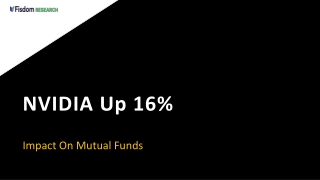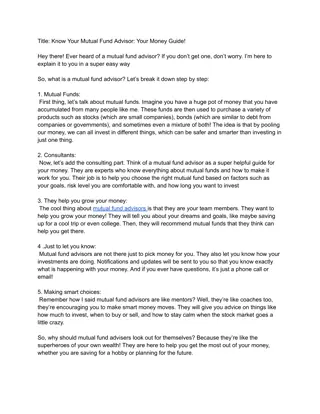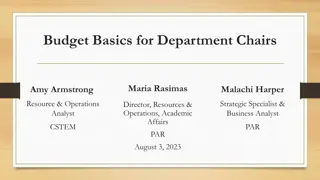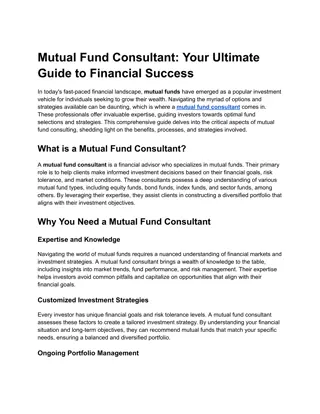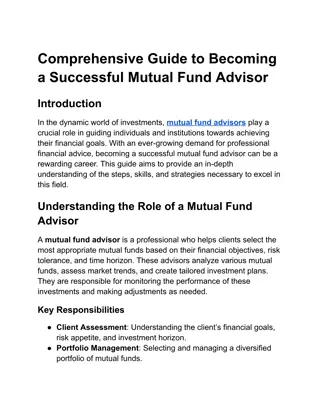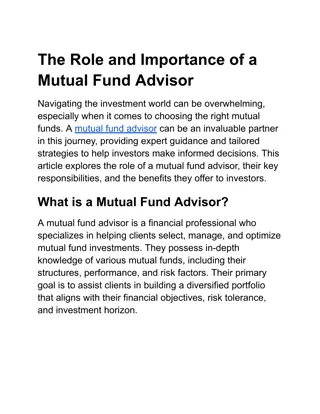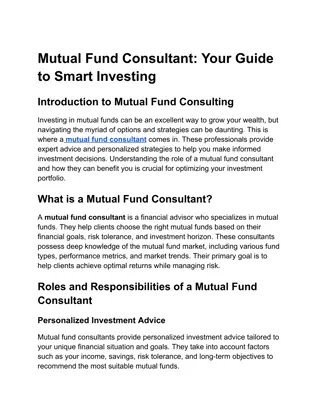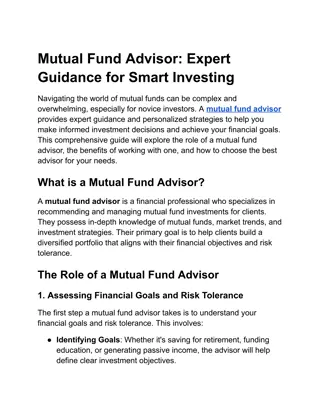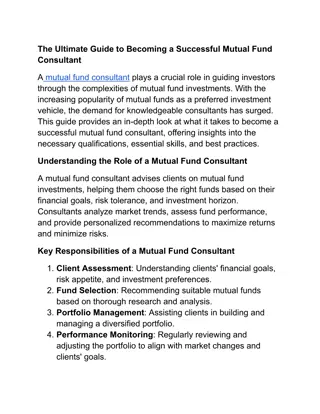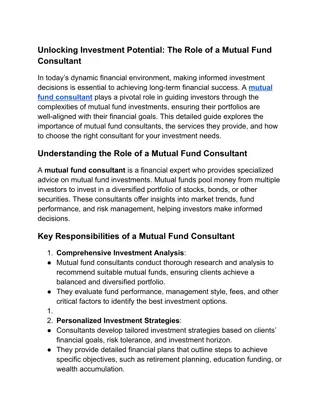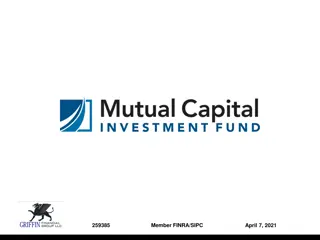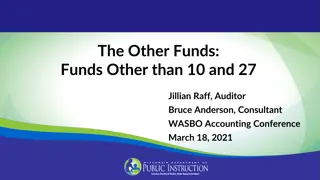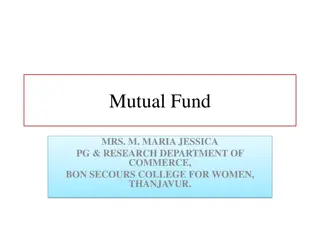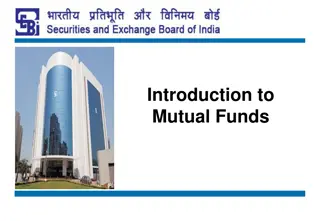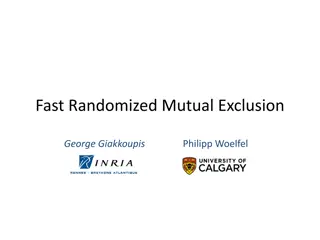
Steps for Selecting and Purchasing Mutual Funds
Learn how to select and purchase mutual funds step by step. Find a licensed broker, open an account, and use an online mutual fund screener to make informed choices. Understand criteria like asset class and Morningstar ratings to make wise investment decisions.
Uploaded on | 0 Views
Download Presentation

Please find below an Image/Link to download the presentation.
The content on the website is provided AS IS for your information and personal use only. It may not be sold, licensed, or shared on other websites without obtaining consent from the author. If you encounter any issues during the download, it is possible that the publisher has removed the file from their server.
You are allowed to download the files provided on this website for personal or commercial use, subject to the condition that they are used lawfully. All files are the property of their respective owners.
The content on the website is provided AS IS for your information and personal use only. It may not be sold, licensed, or shared on other websites without obtaining consent from the author.
E N D
Presentation Transcript
Selecting and purchasing Selecting and purchasing mutual mutual funds funds
I. Step 1 - Find a licensed broker. A. If your employer does not have an investment plan (like a "401k" or "403b") which allows you to purchase mutual funds directly from your paycheck, you can purchase them through a licensed stock broker. 1. Note: If you buy mutual funds through an employer investment plan, you will pay a large fee if you withdraw your money prior to the retirement age of 59 1/2. 2. If you buy mutual funds through a licensed broker, you can withdraw it anytime you like.
I. Step 1 - Find a licensed broker. B. A convenient way to purchase mutual funds is to use an online brokerage firm. These two websites rank some of the better ones. 1. http://www.savings-secrets.com/ 2. http://tinyurl.com/hn39yjr
II. Step 2 - Open an account with the broker. A. As a minor, you would need a parent to open a "custodial" account for you. B. Then you will send money to the brokerage firm to invest with. C. They will hold your money for you so that it is ready to use as soon as you have selected your mutual funds.
III. Step 3 - Use an online mutual fund screener to find a mutual fund that you like. A. A mutual fund screener will allow you to filter the thousands of mutual funds that exist down to a relatively small list that you can select from. B. The online brokerage firm will almost certainly have a mutual fund screener that you can use once you have an account. C. A good one to practice with might be fidelity's, but this will not show all of the funds that will be available to you with your online brokerage firm. 1. https://www.fidelity.com 2. Under "Research," select "Mutual Funds"
III. Step 3 - Use an online mutual fund screener to find a mutual fund that you like. D. The criteria used in a mutual fund screener: 1. Asset class: Here, you will select what you want your mutual fund to invest in. a. Remember, mutual funds that buy stock in U.S. companies are called "U.S. Equity" or "Domestic Equity" mutual funds.
III. Step 3 - Use an online mutual fund screener to find a mutual fund that you like. D. The criteria used in a mutual fund screener: 2. Morningstar Rating: Morningstar is a company that "grades" mutual funds with a 5 star scale. a. Morningstar gives more stars to mutual funds that it expects to perform well in the future. b. Of course, Morningstar could be wrong.
III. Step 3 - Use an online mutual fund screener to find a mutual fund that you like. D. The criteria used in a mutual fund screener: 3. Transaction fees or "Loads. a. These are fees you pay when you buy a mutual fund. b. There are many "no-load" or transaction free funds available.
III. Step 3 - Use an online mutual fund screener to find a mutual fund that you like. D. The criteria used in a mutual fund screener: 4. Returns: a. This is how profitable the mutual fund has been in the past. b. This one is particularly important. 5. Expenses: This is a measure of how much it costs to own the mutual fund.
III. Step 3 - Use an online mutual fund screener to find a mutual fund that you like. D. The criteria used in a mutual fund screener: 6. Minimum initial investment: a. Many mutual funds require you to spend a minimum amount of money to get started. b. When you first start out, you will need to find a fund with a low minimum.
III. Step 3 - Use an online mutual fund screener to find a mutual fund that you like. D. The criteria used in a mutual fund screener: 7. Other criteria: Look around and see what other criteria you may want to use. 8. Rank order the mutual fund by whatever criteria matters to you the most. a. Perhaps by performance over 5 years
IV. Step 4 - Look at individual mutual funds: A. NAV - Net Asset Value: This is how much it costs to buy one share of the mutual fund. B. Performance: 1. This shows the "rate of return" that the mutual fund has provided to its investors over time. 2. Mathematically, it is the same as the interest rate, but with mutual funds it is called the "rate of return" instead of the interest rate. 3. See how it compares to the stock market in general.
IV. Step 4 - Look at individual mutual funds: C. Expense Ratio: 1. This is the % of your invested money that goes to the fund manager who runs the fund. 2. It is subtracted from the fund's rate of return.
IV. Step 4 - Look at individual mutual funds: D. Fund Manager: 1. This is the person who manages the mutual fund, deciding which stocks to buy and sell. 2. In a sense, when you buy a mutual fund, you are really investing in this individual person because he or she is the one actually investing your money. 3. Notice how long the current manager has been managing the fund. a. If the fund has done well over the last 10 years but the current fund manager has only been managing the fund for 1 year, than the fund's performance does not necessarily reflect the current managers ability.
IV. Step 4 - Look at individual mutual funds: E. Holdings: 1. These are the companies that the mutual fund currently owns stock in. 2. See if there are any that you know and like. F. Look around at anything else that looks interesting to you.
V. Step 5 - Buy the funds you like. A. Remember to diversify by investing in different "squares" in the overall investment style square.
V. Step 6 When should you do all of this? A. You should invest in mutual funds when you can leave your money invested for 5 years or more. B. Investing for a shorter time is much more risky since losses are much more possible during that short a time.
V. Step 7 Monitor your investment. A. Check your investment value regularly. B. Remember, you are investing for the long term, so you should not sell and buy and sell and buy every time the value of your mutual fund goes up and down. C. However, if for several months your mutual find is consistently performing significantly worse than the market in general or than other similar mutual funds, it might be time to sell it and invest in a better performing stock.


